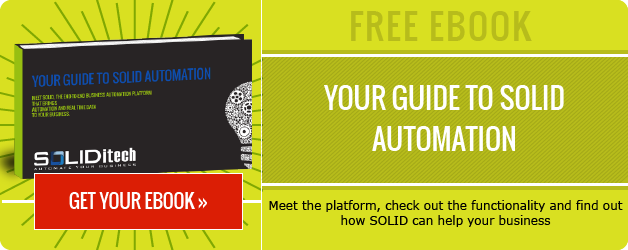You can’t seem to read an article these days without bumping into terms like ‘Business Process Automation’, ‘BSS/OSS’, or ‘Automated operations’. These terms are popular because they describe real solutions to problems such as operational visibility and process complexity.
So, it’s clear that automation can actually help, but the most pressing questions you have are ‘how’ and ‘why??’.
To answer your questions we’ve written this guide. It runs through automation from A-Z, explaining how it gives you the information and infrastructure you need to propel your business forward - and why you should automate your business.
A Beginners Guide: Why Automate Your Business
What it means ‘to Automate’
Automation has been around for longer than you think… Much longer.
Think about how ancient civilisations used to transport water: It all started with people walking buckets backwards and forwards until someone decided that aqueducts were a far more efficient delivery mechanism.
The bucket system was fraught with problems and dependant on too many variables to be reliable. Buckets might break or be different sizes; people would fill the buckets to different levels, walk at different speeds or need time off. And to top it all off, water would be spilled along the way.
The development of aqueducts allowed the ancients to automate water delivery by diverting streams into man-made channels, directing the water to where it was needed without the use of buckets. In the same way, modern day automation channels tasks to their destinations via preprogrammed computer processes, with no need for manual intervention.
TechTarget have summarised IT automation brilliantly by saying that “IT automation is the linking of disparate systems and software in such a way that they become self-acting or self-regulating”. Meaning that that step-by-step processes happen automatically, without a human having to be involved once the process has begun.
Automation is all about turning tedious and repetitive manual tasks into streamlined, computer-operated automated processes.
Why would a business consider automation?
Almost all manual processes from delivering buckets of water to fulfilling a customer's order encounter the same types of problems. With operational processes, however, the results are a lack of visibility of key business statistics, ineffective procedures, low customer satisfaction and revenue leakage (remember that spilled water?).
As aqueducts brought visibility, efficiency and consistency to water delivery, so business process automation brings them to your everyday operations.
The Biggest Benefits of Automation
Primary Benefits
Once a process is adapted from being manual to being computer-driven, there are 3 primary benefits: [We’ve gone into much more detail in this post]
- Time Savings: Machines process millions of instructions per second, can do multiple tasks at once, and don't need to sleep. Therefore, tasks are completed much quicker, and in bulk.
- Money Sayings: Whilst initially a fair investment, software and hardware costs are quantified over time. Machines can run faster and for longer than their human counterparts. Therefore, money is saved as the capital cost per task becomes drastically reduced over time and fewer resources are required
- Consistency & Quality: Machines do exactly the same thing every time. A process will be completed one way, and one way only. They are not dependent on the subjective interpretation of a process between different people performing a task. Therefore, tasks are 100% guaranteed to be completed to your specifications, each and every time they are executed.
What this means
More importantly though, is what your newly found speed, savings and consistency actually mean in real terms:
- Recovered Revenue leakage: Manual processes are dependant on people (just like the bucket delivery system) and thus they are open to human error. This, combined with procedural inefficiencies rapidly promotes revenue leakage (NOT a friend of business!). Automation removes these factors, and, along with increased accuracy in billing and collections, allows you identify the sources of revenue leakage and plug them.
- Reduced Customer Churn: Tools such as automated provisioning and customer self-service portals go a long way to increasing customer satisfaction and therefore reducing churn. Furthermore, being able to perform tasks quicker and more consistently promotes increased customer satisfaction.
- Increased Visibility of Key Metrics: Automated process can be benchmarked, measured and recorded. These statistics are easily available through dashboards and can be analysed and reported on at any time.
- Reduced Time to Market: Tasks that can be completed quicker and easier with better visibility of key information means that you’re able to respond to your customers needs with more agility, and deliver products to the market quicker and more effectively. Automated provisioning is a big contributor to this.
Be Careful to Keep These Things in Mind
- Automation is an investment: Both financially and in time. One of the biggest myths we face is that you can ‘set and forget’. Your processes, as your business does, constantly evolve and you need to remain aware of what processes you have put in place, how they are working for you and when/if they can be improved to achieve your business goals.
- It requires careful change management: Automation can come up against opposition within organisations when people are concerned that they will lose their jobs.
“To the contrary, we often find that once people’s time has been freed up from menial, repetitive tasks they are free to be placed in positions that really matter, using their creativity and ability to make more qualitative judgement calls” [Christopher Hamman, SOLIDitech Solution Architect]. The whole process from investigation to implementation needs to be carefully managed to ensure that your staff remain on-board and positive towards the change.
- You need to select the right partner: For any long term investment, it’s imperative that you pick the right partner. Someone who understands your needs and has the ability to grow with you. Our eBook ‘6 Questions to Ask Before Choosing your Business Automation Software’ can help you identify which company to partner with.
- You need to clearly understand what you’re trying to achieve: Rubbish in, rubbish out. To succeed with automation you need to have a very clear idea of your objectives and exactly how you’d like to achieve them. Once a process has been implemented, automation ensures it happens very quickly, multiple times - so problems can very quickly grow exponentially.
Lastly, don’t forget to check out our Best Tips for Automation Success and if you'd like to know more about Automation in general, make sure you head over to our blog post "Everything You Need To Know About Business Process Automation".
I hope this guide has helped. Please pop any questions/comments you have in the comments section below.









Comment